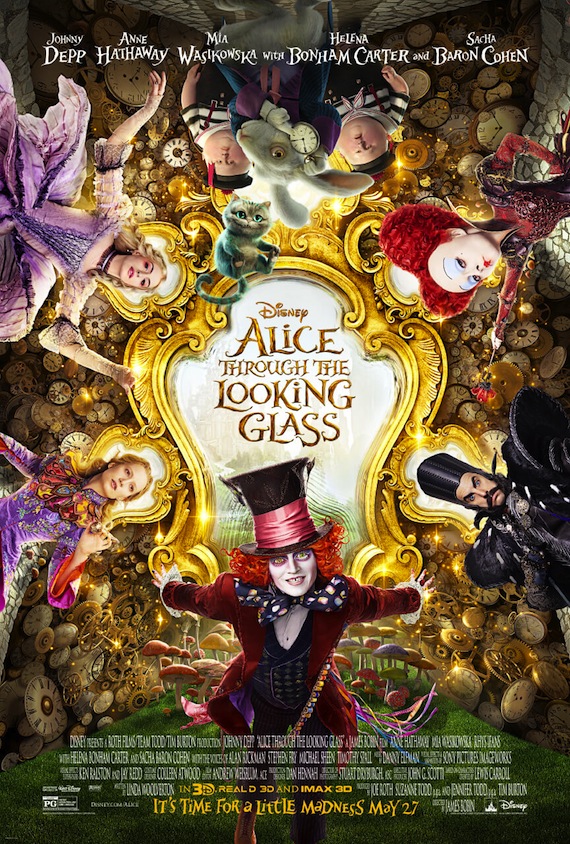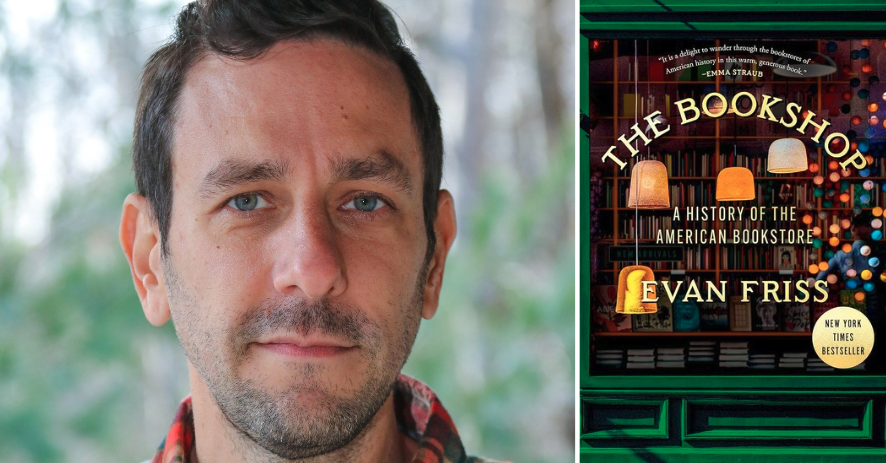
Hollywood is no place for nonsense. That’s presumably why Alice Through the Looking Glass, the sequel to Disney’s 2010 movie Alice in Wonderland, features organizing principles absent from Lewis Carroll’s books: Alice’s search for a “chronometer” — a time travel device that’s also a pacemaker for Father Time (Sacha Baron Cohen, with mutton chops, German accent, and mustache) — paired with a search for the missing family of the Mad Hatter (Johnny Depp, eyes painted yellow like a gecko).
 For the story to make sense, director James Bobin needed a proper quest with proper villains attached; most of all, he needed a linear story that unfolds in time. But time is almost totally meaningless in Carroll’s Wonderland. On the contrary, a timeless, dreamy indolence prevails. In Carroll’s books, there isn’t any story in the conservative Hollywood sense, and there’s certainly no systematic antagonist to satisfy a Hollywood film editor.
For the story to make sense, director James Bobin needed a proper quest with proper villains attached; most of all, he needed a linear story that unfolds in time. But time is almost totally meaningless in Carroll’s Wonderland. On the contrary, a timeless, dreamy indolence prevails. In Carroll’s books, there isn’t any story in the conservative Hollywood sense, and there’s certainly no systematic antagonist to satisfy a Hollywood film editor.
The only villain in Carroll’s Wonderland is overzealous conscience, and the means available to combat it are wholly stylistic, a unique brand of literary anarchy that owes much to the repressive Victorian era: Carroll was born in the teeth of the Evangelical religious revival that defined it. As Josef Altholz writes, “The most important thing to remember about religion in Victorian England is that there was an awful lot of it.” Threatened by the advance of science and secularism in the 18th century, clergymen of the 19th fought to defend the old moral order by clamping down firmly on new ideas. Lewis Carroll’s father was a reverend and archdeacon in this reactionary Evangelical movement, which also conscripted Carroll himself. Biographer Derek Hudson writes that “it is beyond dispute that Lewis Carroll modeled his outward character largely on his authoritarian father.” Carroll was ordained a clergyman like his father and his colleagues in mathematics at Oxford. But this proper “outward character” had a rebellious counterpart in an inner character that authored puckish, nonsensical books.
Verbal humor was from childhood Carroll’s favored means of breaking rules. When he was 13, he wrote a satirical poem called “Rules and Regulations” and another called “My Fairy.” His “fairy” was an inner voice of conscience whose basic message was You mustn’t…do anything. This was the beginning of Carroll’s career undermining authority figures by impersonating their voices, a strategy that would culminate in hilarious creations like the King and Queen of Hearts, the Duchess, and the Mock Turtle. Their lunacy derives not so much from disregard for rules as from rigid observation of rules that don’t make any sense. The system of Wonderland runs on madness and everybody living there abides by it. Thus the Cheshire Cat judiciously assures Alice that she needn’t bother avoiding mad people in Wonderland. “Oh, you can’t help that,” he says, “we’re all mad here.”
Consider how the Duchess, depicted by 19th-century illustrator John Tenniel as a man in a squared Elizabethan headdress, nurses her baby in a kitchen full of pepper. “I speak severely to my boy, I beat him when he sneezes,” she sings. And then this:
‘Here! You may nurse it a bit, if you like!’ the Duchess said to Alice, flinging the baby at her as she spoke. ‘I must go and get ready to play croquet with the Queen,’ and she hurried out of the room. The cook threw a frying-pan after her as she went, but it just missed her.
It’s telling that the insane Duchess’s favorite word, as Carroll later observes, is “moral.” It is her devotion to a crooked dogma that makes her seem unhinged: an infant is not allowed to sneeze; a game of croquet outweighs the baby’s needs. Invitations to the Queen’s officious game of croquet, meanwhile, arrive in large wax-sealed letters, whence footmen read them aloud. To make all this ceremony even more preposterous, the game is ultimately played with flamingoes and hedgehogs instead of mallets and balls. The courtiers’ fastidious efforts at croquet quickly bring about nothing but chaos as the animate balls, mallets, and wickets wander off. The game is mad, not the players.
Sigmund Freud said that good jokes free us from the prohibitions of reserved, polite society, and Carroll sets us all free: authority figures so corrupt and ridiculous can’t enforce their prohibitions. The Queen of Hearts, Carroll says, has “only one way of settling all difficulties, great or small” — and that is to cry, “Off with his head!” She and the King, who eventually serves as the most maddening trial judge in all literature, are a perfect picture of the excess and irrationality of a neurotic conscience. Alice accordingly rejects their corrupt judgments; when the Queen hysterically demands Alice’s head, Alice silences her with this assessment of her moral code: “Nonsense!”
The Cheshire Cat is one of the few characters who seems in on the joke of Wonderland. So is the Gryphon, who doesn’t fear “that savage Queen.” In fact, he says, she’s “fun.” “It’s all her fancy, that,” says the Gryphon in his candid patois. “They never executes nobody, you know.” The Gryphon pronounces a similar verdict on his companion, the sorrowful Mock Turtle, whose name derives from a Victorian dish called “mock turtle soup.” “It’s all his fancy, that,” says the Gryphon. “He hasn’t got no sorrow, you know.” In Wonderland, sorrow is just another preposterous rule. Carroll illustrates this point when Alice asks the source of the Mock Turtle’s woe and receives this sniffling and incomplete explanation: “Once, I was a real Turtle.” His sorrow derives, it seems, from an affectation, a “mock sorrow” to which he feels unaccountably obliged. But the reader recognizes instantly the absurdity of this obligation. We have as little to fear from mock sorrow as we do from the Queen’s mock executions.
Throughout the books, it’s Alice who is the principal skeptic of Wonderland’s regulations and the spurious sorrow, guilt, and fear they entrain. By appointing a child the cynosure of wisdom in his books, Carroll broke with the standard approach to children’s literature in Victorian times. Victorian children’s literature treated children as eminently corruptible and sought to provide them with stern moral instruction. Carroll used Alice like a mini-Friedrich Nietzsche to do the opposite — to critique the bad morals of adults — and as a sort of straight man in a comic routine. She points out absurdity so that the reader can not only appreciate its latent social commentary, but enjoy it, revel in it, laugh at it. Nonsense is a relief to the child from the bullying strictures of reality, but it’s perhaps an even bigger relief to adults, who suffer even more of reality’s insults and constraints, and who have lost the childhood method of defying reality through nonsense.
Lewis Carroll, however, seemed to have recovered the pleasurable nonsense available to children by retaining in himself the ability to be a child. As is well-known, Carroll composed the earliest version of the Alice stories to entertain a real little girl, 10-year-old Alice Liddell, daughter of a lexicographer of ancient Greek at Oxford. His unorthodox friendships with Alice and other little girls have led some scholars to call him a pedophile; the intensity of Carroll’s interest in the Liddell girls may indeed have precipitated the break with the Liddell family that eventually ensued. Regardless of the ultimate propriety of these relationships, Carroll’s urge and ability to see the world through the eyes of a child is inseparable from his artistic vision. Among the many rules that Wonderland warps to the breaking point is that which divides big and small, adult and child. When Alice literally grows and shrinks in Wonderland, she seems to illustrate Carroll’s wish, and his corresponding ability, to toggle between child and adult by an act of mental flexion or extension. Age, like time, does not exist in Wonderland.


 Carroll’s personal interest in the world of childhood, his professional interest in symbolic logic, and his rebellion against over-finicky rules all came together in nonsense verse like “Jabberwocky,” which famously begins, “Twas brillig and the slithy toves / Did gyre and gimble in the wabe.” Seth Lerer writes, “[T]he idea of nonsense as a force of the imagination, of nonsense as a challenge to the logic of adulthood and the laws of civil life — this was a new idea in Victorian England. The masters of that nonsense were, of course, Lewis Carroll and Edward Lear.” Carroll’s nonsense has indeed been influential and long-lived; it gave English the portmanteau word “chortle” and inspired The Beatles’s famous song “I Am the Walrus.” John Lennon told the BBC that his 1967 nonsense song refers to “The Walrus and the Carpenter” from Carroll’s Through the Looking Glass. A century after Carroll made war on the Victorians, Lennon channeled his nonsensical idol to continue the very same culture war, to relieve us of our mock sorrows.
Carroll’s personal interest in the world of childhood, his professional interest in symbolic logic, and his rebellion against over-finicky rules all came together in nonsense verse like “Jabberwocky,” which famously begins, “Twas brillig and the slithy toves / Did gyre and gimble in the wabe.” Seth Lerer writes, “[T]he idea of nonsense as a force of the imagination, of nonsense as a challenge to the logic of adulthood and the laws of civil life — this was a new idea in Victorian England. The masters of that nonsense were, of course, Lewis Carroll and Edward Lear.” Carroll’s nonsense has indeed been influential and long-lived; it gave English the portmanteau word “chortle” and inspired The Beatles’s famous song “I Am the Walrus.” John Lennon told the BBC that his 1967 nonsense song refers to “The Walrus and the Carpenter” from Carroll’s Through the Looking Glass. A century after Carroll made war on the Victorians, Lennon channeled his nonsensical idol to continue the very same culture war, to relieve us of our mock sorrows.
It is this joyous relief and freedom that resounds throughout Wonderland. Adults continue to return to Lewis Carroll in order to retrieve what Freud called “the lost laughter of childhood.” Unlike J.M. Barrie, author of Peter Pan, or A.A. Milne, author of Winnie-the-Pooh, Lewis Carroll grants no asylum to wistful acknowledgements that childhood must come to an end. The lost laughter of childhood needn’t be lost forever, he seems to say. Whether Hollywood, with all its starched conventions and obligations to the Almighty Dollar, can ever retrieve the lost laughter as well as Carroll did is an open question. The Alice movie currently in theaters now doesn’t really aim to. It peddles instead a familiar spectacle, manipulating the audience’s attention, which suited my kids just fine. This grown-up, though, finds more sense in Carroll’s nonsense. Maybe that’s why Carroll’s books are still in print. Nothing funnier has ever been written.








